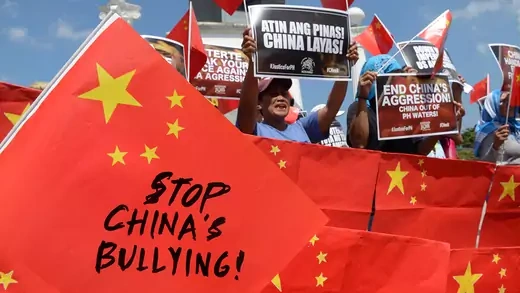By Joshua Kurlantzick
The Chinese government’s increasingly aggressive diplomacy has hurt its image in much of the world. It’s unlikely to improve anytime soon.
The upcoming Winter Olympics in Beijing has heightened international scrutiny of the Chinese government’s rights abuses. But even before the games, China’s global public image had taken an enormous beating.
China’s public image “remains broadly negative” in many countries, according to a study by Pew Research Center. In Australia, a place where the public held a positive image of China in the late 2010s, only about 20 percent of people have a positive image of it today. In Japan, just 10 percent of people have a favorable image of China. In addition, prominent opinion leaders in many nations are now implementing diplomatic boycotts of the Winter Olympics, and even some of Beijing’s most ardent past supporters, such as trade organizations, have increasingly expressed dissatisfaction and anger with China.
This decline in Beijing’s image has consequences for its influence abroad, but Chinese officials seem reluctant to do anything to fix it.
Why has the Chinese government’s public image worsened?
Beijing’s global public image has deteriorated for several reasons. In some countries, there remains a reservoir of mistrust of Beijing over its cover-up of the initial COVID-19 outbreak. Also, some of China’s Belt and Road Initiative (BRI) projects have generated negative press, as countries amassed higher-than-expected debt. Beijing’s rising authoritarianism at home, particularly its strangling of Hong Kong’s freedoms and its crackdown in Xinjiang, has soured many foreign publics.

In recent years, China has adopted an increasingly coercive, belligerent style of diplomacy, called wolf warrior diplomacy, that has alienated countries in its neighborhood and as far away as Lithuania, which Beijing bullied for allowing Taiwan to open a representative office in its capital city of Vilnius. But rather than seeing results in its favor, Beijing’s increasingly aggressive approach has backfired in many countries. In the case of Lithuania, the country refused to stand down and European countries rallied behind it.
Where has Beijing’s image declined?
China’s public image remains poorest in developed democracies in Asia, such as Japan and South Korea, North America, and Western Europe. Not only have publics in these countries developed intensely negative views of China, but many of their governments are shutting down important Chinese soft power initiatives, such as Confucius Institutes, which offer Chinese language and culture programs at colleges and universities around the world.Dive DeeperChina’s Approach to Global Governance
Its image has taken less of a hit in other parts of Asia and in Africa. Some Asian countries with close historic ties to China, such as Singapore, Thailand, and Pakistan, have responded more favorably to Chinese public diplomacy, and they’ve typically not faced the more coercive diplomacy. In some African countries, Beijing has funded needed infrastructure projects and hired local workers, winning goodwill that it hasn’t totally squandered.
How damaging has this been?
China’s declining image has caused geostrategic and economic pain. An investment agreement with the European Union has been put on hold, and many European countries that originally welcomed BRI projects have soured on them. The BRI is stalling in places beyond Europe as well, partly because of China’s wolf warrior diplomacy and fears that the BRI is linked to corruption and debt. The U.S.-China relationship is now at its lowest point in decades, endangering trade ties and heightening the risk of major-power conflict.
How is Beijing attempting to improve its image?
In a speech last year, Chinese leader Xi Jinping appeared to call for reining in wolf warrior diplomacy and promoting Beijing as a reliable and relatable partner. The country’s massive soft power campaign over the past decade has also included an expansion of its global state media outlets. But China’s state media has gotten only minimal market share in most countries.
During the pandemic, China has become a major international donor of vaccines, though it hasn’t donated as many as the United States. Yet, countries such as Malaysia are rejecting Chinese vaccines that do not appear as effective as others.
Meanwhile, some Chinese opinion leaders—perhaps even Xi, who continues to promote wolf warrior diplomats, including in posts in the United States—believe that China should not change its increasingly aggressive stance, even if it results in a negative image abroad. They argue that China, as a rising and assertive power, will always be resented by leading democracies that try to curtail it. This aggression also seems to please much of the Chinese public, which has become more and more nationalistic. Indeed, China has continued its coercive tactics not only with Lithuania but also with Australia and many others.
How should the United States respond?
Washington could let Beijing continue digging its hole and, meanwhile, rebuild U.S. ties with democratic partners. China’s coercive measures could ultimately alienate even more countries and benefit the United States.
However, the United States should remain vigilant about Chinese efforts that cross the line from soft power into so-called sharp power—efforts to covertly and often coercively influence public discourse. These could include directly wooing foreign politicians via backdoor channels and with bribes, using disinformation tactics online to promote Chinese government ideas, or having pro-China businesspeople buy up local press outlets and quietly alter their coverage to be more favorable toward Beijing.Creative Commons: Some rights reserved.

